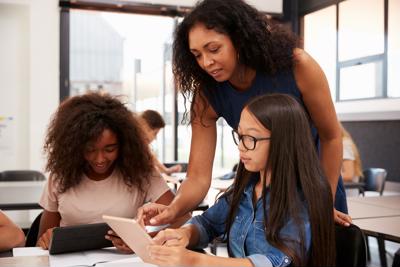How Education Companies and Their Products Can Help Teachers
Embracing Educational Technology
How can more teachers integrate educational technology into their classrooms in a productive way that builds on their skills and improves learning?
Teachers and administrators can have misconceptions about what technology usage means for their classrooms because they may not completely understand its benefits. This confusion can lead to hesitancy to embrace the benefits of using technology and tools. Education companies that provide digital tech need to work to convey the product’s advantages to those with buying power. But even from there, the most important thing is that the teachers fully understand how to use this new technology.
In 2020, school districts were forced to embrace technology due to the COVID-19 pandemic. According to the United States Census, about 93% of students had to adapt to distance learning during that period. Many teachers and students were uncomfortable with remote learning or the associated tools but quickly had to learn.
The administration needs to do its part to increase the number of teachers who embrace technology with wholehearted vigor. For example, a leader within the school explains the associated benefits of these tools or implements explicit training to ensure that educators feel empowered to use the edtech
Keep in mind that teachers are already busy with their day-to-day commitments, and a confusing new education technology could be considered more inconvenient. Because of their time constraints, it is the administrator’s responsibility to make time for the available resources to be understood completely.
 Educational Technology
Educational Technology
Advantages of Ed-Tech
When the educational experts who teach America’s students use technology to boost their lesson plans, the result can be a better-educated student. Brookings has identified four different comparative advantages of technology:
- Boosting differentiated instruction
- Expanding opportunities for practice
- Elevating learning engagement
- Scaling up standardized instruction
The end goal is to improve the quality of instruction and overall student education, which is more important than ever. Since the pandemic has put many students behind the curve, many teachers have to play catch up now that most schools are back to in-person instruction. Technology can be an essential part of closing this education gap.
Barriers to Adoption
If there are so many benefits to learning technology, why isn’t every school full of personalized computers and smartboards?
While some teachers are hesitant, many would be grateful for the assistance that technology can provide, but this is not always possible. Underprivileged schools across America are struggling to access new textbooks and other essential resources, which leaves little room in the budget for expensive technology.
 Educational Technology
Educational Technology
This digital inequality is pervasive and affects those in low-income areas the most. Learners from these regions often lack the skill sets to use edtech in the first place, which became abundantly clear during 2020 when remote learning was necessary. Because some students are unlikely to access tech or internet connection at home, they need to learn the skills to use the tools at school if possible. However, the learners who need additional support are more likely to be in an underfunded school district.
Education is also struggling in other fundamental areas, such as hiring qualified teachers to fill classrooms. The truth is that technology could be beneficial in many circumstances. Still, it is not the priority of the school districts facing teacher shortages.
Education companies need to help administrators understand that edtech, and the training to use it, is a crucial component of creating a support system for educators. Implementing new ways of instructing can be overwhelming to a teacher who already has a full plate, which is why they need to feel supported to this end.
Where to Begin
There should be an emphasis on individualized pitches for education companies with the technology available to help schools. Understand the specific needs of the school and district, and meet them where they are.
For example, some schools lack the infrastructure, like internet connectivity, to support edtech. If this is the case, suggest another more logical implementation that aligns with the educator’s requirements.
There are vast differences between schools in different parts of the country, and each has its own technological needs. In addition, some school districts still operate in a blended learning environment, which would require a unique digital solution.
Other factors inform a school’s tech needs, like location, student population, or testing scores. Transparency and communication are essential. Administrators, teachers, students, and parents must be on board for a clear path to success.
Are you ready to learn more about how to enhance instructional quality by implementing educational technology? Reach out to Agile today!